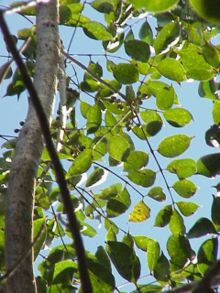Bursera: Difference between revisions
Content deleted Content added
Benny White (talk | contribs) m grammar |
|||
| Line 119: | Line 119: | ||
===Formerly placed here=== |
===Formerly placed here=== |
||
*''[[Canarium paniculatum]]'' <small>(Lam.) Benth. ex Engl.</small> (as ''B. paniculata'' <small>Lam.</small>) |
*''[[Canarium paniculatum]]'' <small>(Lam.) Benth. ex Engl.</small> (as ''B. paniculata'' <small>Lam.</small>) |
||
* |
*[[Protium (plant)|Protium serratum]] <small>(Wall. ex Colebr.) Engl.</small> (as ''B. serrata'' <small>Wall. ex Colebr.</small>)<ref name=GRINSpecies/> |
||
==Gallery== |
==Gallery== |
||
Revision as of 10:24, 28 March 2015
| Bursera | |
|---|---|

| |
| Bursera simaruba | |
| Scientific classification | |
| Kingdom: | |
| (unranked): | |
| (unranked): | |
| (unranked): | |
| Order: | |
| Family: | |
| Genus: | Bursera |
| Type species | |
| Bursera simaruba | |
| Species | |
|
About 100, see text. | |
| Synonyms | |
|
Elaphrium Jacq. | |
Bursera, named after the Danish botanist Joachim Burser (1583-1639), is a genus with about 100 described species[2] of flowering shrubs and trees varying in size up to 25 m (82 ft) high. They are native (often for many species endemic) to the Americas, from the southern United States south through to northern Argentina, in tropical and warm temperate forest habitats.
A number of species from tropical Asia were once included in this genus, but are now treated in the genus Protium.
Species
Formerly placed here
- Canarium paniculatum (Lam.) Benth. ex Engl. (as B. paniculata Lam.)
- Protium serratum (Wall. ex Colebr.) Engl. (as B. serrata Wall. ex Colebr.)[3]
Gallery
-
Bursera penicillata trunks
-
Bursera penicillata fruits and leaves
-
Bursera penicillata trunk
References
Wikimedia Commons has media related to Bursera.
Wikispecies has information related to Bursera.
- ^ "Genus: Bursera Jacq. ex L." Germplasm Resources Information Network. United States Department of Agriculture. 2007-10-05. Retrieved 2010-11-18.
- ^ a b Becerra, Judith X.; D. Lawrence Venable (2008). Rees, Mark (ed.). "Sources and Sinks of Diversification and Conservation Priorities for the Mexican Tropical Dry Forest". PLoS ONE. 3 (10): e3436. doi:10.1371/journal.pone.0003436. PMC 2562985. PMID 18927613.
no
{{cite journal}}: CS1 maint: unflagged free DOI (link) - ^ a b "GRIN Species Records of Bursera". Germplasm Resources Information Network. United States Department of Agriculture. Retrieved 2010-11-18.



